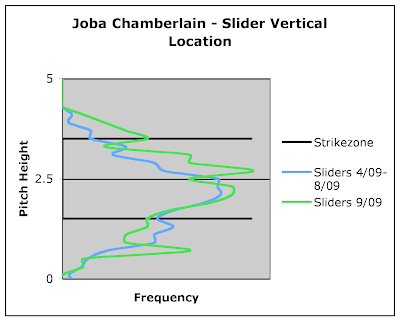A few days ago, I read an
interesting article over on River Ave. Blues that measured the plate discipline of Yankees' hitters by their out-of-zone swing to in-zone swing ratios. In the article, Joe Pawlikowski noted that the point of the metric is to filter out the type of hitter that doesn't swing at all (there's a
good post about this, too, using Brett Gardner as an example). Ideally, you want a player that doesn't swing at pitches out of the zone and swings at pitches in the zone, though players can obviously be successful as "bad ball" hitters (just ask
Pablo Sandoval). Using Pawlikowski's metric as a model, I wanted to figure out for myself who had the best plate discipline in the majors last year. I used Z-Swing/O-Swing to make a higher number more favorable, and this was a raw ratio. In 2009, the average Z-O ratio was 2.63 (65.9% Z-Swing to 25.1% O-Swing). To make the overall number more presentable, I divided each player's Z-O ratio by the league average and then multiplied by 100 (the same scale as ERA+, OPS+, wRC+, etc.). Here's the top 5 for hitters, with a minimum of 500 plate appearances - and I must say that I was a bit surprised:
| O-Swing | Z-Swing | Ratio | Plate Discipline Score |
| Chipper Jones | .154 | .727 | 4.72 | 180 |
| Marco Scutaro | .123 | .555 | 4.51 | 172 |
| Lyle Overbay | .152 | .627 | 4.13 | 157 |
| Luis Castillo | .122 | .490 | 4.02 | 153 |
| J.D Drew | .153 | .612 | 4.00 | 152 |
No disrespect to any of the players on this list, but honestly, I expected to see Albert Pujols and/or Joe Mauer at the top. Pujols' PDS was 111, and Mauer's was 103. Let's look at the trailers in this category.
| O-Swing | Z-Swing | Ratio | Plate Discipline Score |
| Chris Young | .365 | .525 | 1.44 | 55 |
| Erik Aybar | .363 | .620 | 1.71 | 65 |
| Bengie Molina | .439 | .770 | 1.75 | 67 |
| Alfonso Soriano | .370 | .722 | 1.95 | 74 |
| Kendry Morales | .323 | .638 | 1.98 | 75 |
For what it's worth, the aforementioned Pablo Sandoval ranked 7th lowest on this list, with a PDS of 76.
I figured that a similar concept could be applied to pitchers in order to see which hurlers "fooled" opposing hitters most frequently. Here, a lower ratio is favorable for pitchers (though a higher PDS is still favorable). I plugged the formula into the 2009 statistics (qualified pitchers with 150+ innings), and came up with a pitching leaderboard:
| O-Swing | Z-Swing | Ratio | Plate Discipline Score |
| Carl Pavano | .316 | .647 | 2.05 | 128 |
| Roy Halladay | .314 | .662 | 2.11 | 125 |
| Chad Billingsley | .302 | .643 | 2.13 | 123 |
| John Lackey | .289 | .621 | 2.15 | 122 |
| Dan Haren | .288 | .628 | 2.18 | 120 |
Really? Carl Pavano? I can't say I would've guessed. Now I am obligated to show the bottom five:
| O-Swing | Z-Swing | Ratio | Plate Discipline Score |
| Brad Penny | .195 | .698 | 3.58 | 73 |
| Jeff Suppan | .206 | .677 | 3.29 | 80 |
| J.A. Happ | .208 | .677 | 3.25 | 84 |
| Kenshin Kawakami | .215 | .674 | 3.13 | 86 |
| Aaron Cook | .222 | .690 | 3.11 | 87 |
All I have to say is WOW, Brad Penny really wasn't fooling anybody last year.
A few closing thoughts: this is hardly a showing of a player's overall strength --- like I said earlier, there are certain hitters who can have success hitting pitches out of the zone, and there are certainly many pitchers who make a career out of in zone misses (a changeup artist like
Cole Hamels, or a flame-thrower like
Justin Verlander, as two examples). There are plenty of other ways I would like to deconstruct the data on this subject, but that will have to be for another post.





